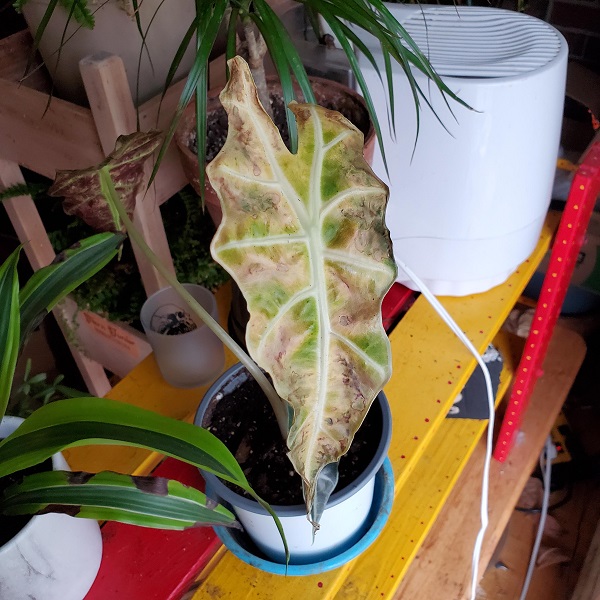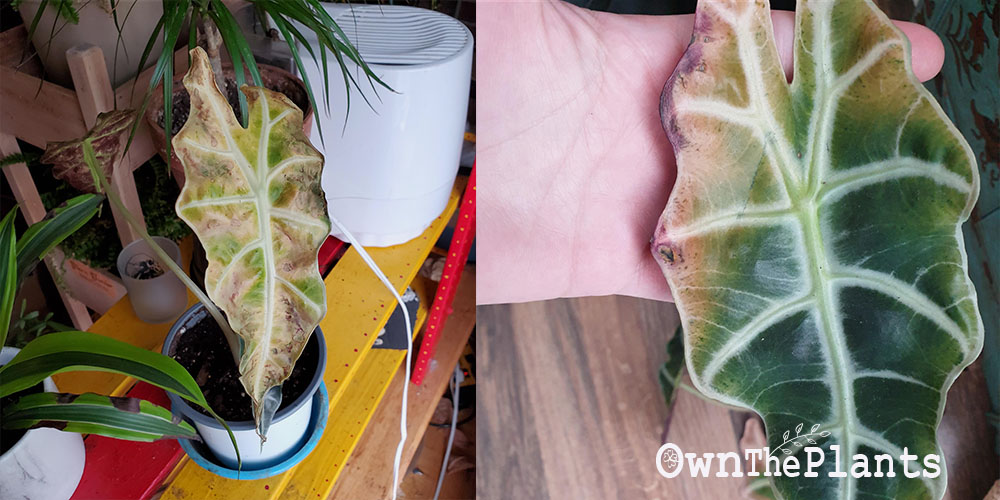It is truly depressing when you see your plant’s health takes a nosedive. You know that there’s something wrong with your plant and that you need to rectify the plant’s situation for it to survive.
But sometimes, the situation is hard to assess that you just don’t know where and how to start saving your plant.
This is a common dilemma for plant owners, especially for Alocasia lovers.
Alocasias are so distinctively beautiful yet delicate enough to be susceptible to many plant risks. They are prone to many plant problems and, consequently, to death if not well taken care of.
But worry not! In this article, we will run through all the possible reasons why your beloved Alocasia plant is dying.
And, of course, we will show you how to turn things around by giving you steps on how to increase its chance of survival.
Why is My Alocasia Dying?

Alocasias are very popular houseplants because of their distinct foliage. However, although these tropical plants are not really divas, they are also not exactly the most beginner friendly.
Depending on the variety or species, your Alocasias can easily be fussy and get into problems.
A dying Alocasia can be due to many factors. It can be due to watering stress, exposure to unfavorable light, temperature, and humidity, or poor soil conditions.
It can also be due to pests and diseases, which require a more urgent fix to avoid spreading to other plants.
No matter the reason, it is important for you to check thoroughly on why your Alocasias are having problems so that you can address them properly.
Remember, different causes require different solutions!
How Do You Save A Dying Alocasia?
As we said before, there is no one fix that can solve all the problems of your Alocasias.
If only there is, we will save a lot of time pondering what went wrong. You must identify the root cause first to correctly give your plants the right solutions.
We will help you get through your dying Alocasia and make it healthy again.
Let’s take a look at the different causes and their respective fixes below.
1. Watering Problem
Your Alocasia plant is very particular about its watering, so excess or insufficient water will surely cause a problem.
Overwatering and underwatering can lead to plant death if not rectified as soon as possible.
To determine what type of watering problem your plant is suffering from, here are the 2 possible situations you must check:
Root Rot Caused by Overwatering
All plant owners dread having root rot since this is one of the main causes of plant death.
There are many possible causes of root rotting, but excessive water is the most common.
Roots soaked in a waterlogged environment for a lengthy amount of time will have a hard time respiring.
Without oxygen, the roots will not able to function well in absorbing water and nutrients for the plant. The plant will wilt and eventually will die if no action is taken.
Root Rot Fix
(1) Allow the soil first to dry out. Ensure that the pot has proper drainage and that no material covers the drainage holes.
Only water again when the soil has been allowed to dry completely. Remember that you only need to keep the soil wet and not saturated or soggy.
(2) Change your pot and your potting mix as necessary. If your soil becomes heavily compacted and waterlogged, discard it and use a fresh, airy mix.
More so, if your pot has insufficient drainage holes, you can add holes at the bottom of the pot.
(3) But most importantly, rectify your watering schedule. Check the top 2 to 3 inches of soil first before watering.
The general rule is that if the top soil is still wet, skip watering on that day. Otherwise, if the soil is already dry and cracky, it’s a sign that your plant needs watering.
Dehydration Caused by Underwatering
A moist (but not soggy!) soil is the best growing medium for Alocasias. Although a brief spell does not affect the plant, a lengthy one can cause serious health issues.
Dehydration prevents your Alocasia from functioning properly, thus, it begins to wilt and shrivel. If left untreated, your plant will surely die.
Dehydration Fix
(1) Examine the growing medium. See if the soil is the right consistency for your plant.
You must frequently water your plant if the soil is too airy and does not hold moisture for long.
Or better yet, change the soil mix into a proper, moisture-holding but well-draining one.
(2) Start watering your plant immediately. You will see that the plant will look so much better in a short time. Rectify your watering schedule to suit the plant’s needs.
Just remember the general rule of watering: water only when the top 2 to 3 inches of soil are dry.
You might also like: Why Are My Alocasia Leaves Mushy? ( 7 Causes + Fix)
2. Light Problem
Improper light conditions can also be detrimental to your plants. Direct sunlight exposure will surely burn the lovely foliage of these plants.
On the other hand, in extremely low light conditions, your plant will not photosynthesize well and thus will not be able to make its own food.
A lengthy amount of time of overexposure and underexposure to light can lead to serious health problems.
That’s why it is best to put your plant where the light conditions suit its needs. Remember that your tropical plants, like Alocasia, thrive best in indirect bright light.
Light Problem Fix
(1) Trim and prune damaged parts. Using a clean, cutting tool for overexposed plants, trim sunburnt parts of the leaves and prune those severely damaged ones.
(2) Place your plant in an east-facing or south-facing windows. These locations in your home give your plant the optimum light conditions it needs. Make sure there is a sheer curtain or shading for sunlight protection.
(3) Consider using grow lights. During winter seasons, or if you have a darker home setting, an artificial light source can help you augment the light requirement for your Alocasia.
(4) Rotate the plant 90 degrees weekly. Plants tend to follow the light source and curve towards it.
Rotating your plant weekly will encourage an even upright growth of your Alocasia.
3. Temperature Problem

A temperature that is out of the optimum range for Alocasia, which is 64-79°F, makes your plant vulnerable to diseases.
Humid, warm temperatures encourage fungal and bacterial growth and other harmful pathogens.
On the other hand, extremely cold temperatures make your plant susceptible to frost bites and may also trigger premature dormancy.
Temperature Fix
(1) Find an optimum location for your plant. Do not let your plant have a temperature below 50°F.
(2) Keep your plant away from cold and hot drafts. If put indoors, make sure to distance your plant from air condition units, refrigerators, heaters, and other cool or hot draft sources.
(3) Find ways to improve air circulation. You may do this by putting a fan nearby or opening windows to allow air to go in and out.
(4) During the winter season, relocate your plant. Your Alocasia is not cold-tolerant, hence it needs to be put indoors or in a more warm location during the cold days.
4. Humidity Problem
As a tropical plant, your Alocasia loves humidity in general. The ideal humidity level for your Alocasia is around 60%.
The leaves will become brown and curly when they are placed in a dry air location.
Humidity Fix
(1) Mist the Alocasia leaves. This is one way to increase humidity around your plants. You may spray it once a week, using distilled water.
(2) Use a humidifier. Consider investing in a good humidifier to keep your plants happy. This is a good way to maintain ideal humidity level indoors.
5. Pest Problem
Alocasias are pest magnets, especially if the environment is extremely moist and slightly warm.
They invite nuisances like spider mites, mealy bugs, aphids, scales, and leafhoppers are just some of the pests that could harm your plant.
The bites of these pests cause browning spots on the leaves and darkened veins.
If left untreated, these pests have the potential to destroy your entire plant collection, as they multiply and spread aggressively.
Pest Infestation Fix
(1) Wash down your plants. Get rid of the pests manually by first, taking your Alocasia to the sink and washing it down. Washing flushes down, not just the pests, but also their eggs.
(2) Spray insecticides/pesticides and horticultural oils. Employ the help of organic chemicals that are proven effective in deterring pests.
You may use any commercially available insecticides, pesticides, or oils and spray them on your plant weekly until pests are no longer present. Neem oil is an effective, natural pesticide.
6. Disease Problem
Browning of your Alocasia can also be due to diseases caused by bacteria, fungi, parasites, and other pathogens.
Leaf spotting is the most common symptom of plant disease, coupled with brown patches on the affected plant part.

Like your pest infestation, diseases in plants should be taken care of immediately.
Not only will it kill your plant, it can also spread to other plants and wreak havoc. The longer the treatment is given, the more serious the problem becomes.
Disease Fix
(1) Isolate and quarantine the diseased Alocasia. This will keep the disease from spreading to other plants.
(2) Remove all affected parts. Discard any part of the plants that show symptoms of diseases.
Do not forget to throw the parts away properly and disinfect the tools used to prevent spreading
(3) Allow good air circulation. Microorganisms thrive and spread quickly when the environment is moist and humid.
(4) Use fungicides/pesticides. When necessary, use commercially available fungicides or pesticides to kill pathogens of your plant. Spray them weekly until the plant recovers.
7. Transplant Shock
Like any other organisms, plants sometimes have a hard time adjusting to their new environment.
It could take weeks before the plant fully adapts to its new place. Stress signs such as yellowing and leaf drying are commonly observed in the process.
With proper environmental conditions, your plant will regain its healthy stature once it has fully adjusted.
Always keep in mind all the necessary requirements for your Alocasia to grow optimally.
How Do You Prevent Alocasia From Dying? (Key Steps of Alocasia Care)
While plant problems are inevitable, you can take steps to prevent your plant from experiencing them frequently.
Here are the key steps of caring for an Alocasia, which will help your plant evade problems at bay:
- Maintain evenly moist soil by having a proper watering schedule and a well-draining potting mix.
- Attain a temperature and humidity level of above 60°F.
- Give proper light conditions to your plant.
Final Thoughts
Always remember that gardening and caring for plants are always met with problems.
There is no perfect gardener or plant owner. Admit that sometimes things just happen, and you just have to deal with them.
In the case of your dying Alocasia, remember to first check the situation at hand and assess.
You can only give your plant the right fix once you correctly identify what’s causing the problem.
Or else, any action you will do will just be futile. Understand the basics and your plant will surely survive and thrive!
If you have relatable experiences with Alocasias, don’t forget to share in the comment section below. We would love to hear from you!
